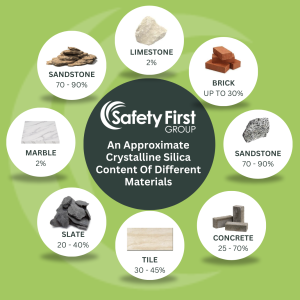Respirable crystalline silica (RCS) is found in stone, rocks, sands and clays.
Silica dust is deadly, killing hundreds of people in the UK each year. Because silica dust is found in a lot of building materials, it’s difficult to avoid. But avoid it, you must. Because the law, and your health, require you to. How much silica dust is harmful, and what are the silica dust exposure limits?
Silica dust kills around 800 people every year in the UK.
And if you work in construction, silica dust is difficult to avoid.
If you carry out work that requires you to cut, sand, drill or carve materials containing silica, you create and release dust. This fine dust is known as respirable crystalline silica (RCS). This fine dust is what can be inhaled deeply into your lungs, causing long-term irreversible damage to your health.
The importance of occupational exposure monitoring
- Producing data to implement remedial actions effectively
- Checking the effectiveness of your control measures
- Ensuring workplace exposure limits are not exceeded
- Identifying health surveillance needs
The most at-risk work includes:
- Construction
- Demolition
- Quarrying
- Mining
- Potteries
- Ceramics
- Manufacturing
Approximate Crystalline Silica Content in various materials

You can find out more about WELs and how to calculate them HERE
Exposure to RCS over a long period can cause fibrosis (hardening or scarring) of the lung tissue with a consequent loss of lung function. Sufferers are likely to have severe shortness of breath and may find it difficult or impossible to walk even short distances or up stairs. The effect continues to develop after exposure has stopped and is irreversible. Sufferers usually become house- or bed-bound and often die prematurely due to heart failure.
Acute silicosis is a rare complication of short-term exposure to very large amounts of silica. This condition is life-threatening and associated with very significant clinical consequences.
Silica may also be linked to lung cancer. Precautions taken to control the risk of fibrosis will serve to control the risk of lung cancer. Workers with silicosis are at an increased risk of tuberculosis, kidney disease and arthritis. Exposure to RCS may also cause chronic obstructive pulmonary disease (COPD).
The Control of Substances Hazardous to Health (COSHH) Regulations apply to any substances that can harm health. That doesn’t just mean chemicals or substances in packaging and containers that you buy in. It also includes hazardous dust that is produced as part of your work processes.
Safety First’s occupational exposure monitoring
Exposure monitoring is needed for work with harmful substances, such as asbestos and lead may also be required as part of the COSHH risk assessments. Our specialist team is highly qualified in the different methods of monitoring exposure. No matter how complex the issue, Safety First can find the right sampling strategy for you.
Safety First is experienced in delivering a complete range of occupational exposure monitoring services to provide you with confirmation that your control measures are adequate and workplace exposure limits are not exceeded.
Contact our friendly team of experts to find out more about occupational exposure monitoring.
